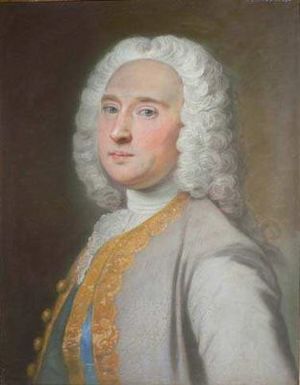Charles Somerset, 4th Duke of Beaufort facts for kids
Quick facts for kids
The Duke of Beaufort
|
|
|---|---|

Charles Noel Somerset, 4th Duke of Beaufort painted by William Hoare at an unknown time.
|
|
| Born | 12 September 1709 |
| Died | 28 October 1756 |
| Spouse(s) | |
| Issue |
|
| Father | Henry Somerset, 2nd Duke of Beaufort |
| Mother | Lady Rachel Noel |
Charles Noel Somerset, 4th Duke of Beaufort (born September 12, 1709 – died October 28, 1756) was an important British politician. He was a member of the House of Commons from 1731 until 1745. After that, he became the Duke of Beaufort, a noble title.
Contents
Who Was Charles Noel Somerset?
Charles Noel Somerset was a significant figure in 18th-century British politics. He came from a powerful family and held strong beliefs. He was known for being a very loyal member of the Tory political party.
Early Life and Education
Charles was the younger son of Henry Somerset, 2nd Duke of Beaufort. His mother was Rachel Noel. He attended Winchester College, a well-known school. Later, he studied at University College, Oxford, starting in 1725. He earned his Master of Arts degree in 1727.
A Career in Politics
Charles Somerset was a strong supporter of the Tory party. He was also known for supporting the Jacobite cause. This meant he believed the Stuart family should be kings of Britain, not the Hanoverian family who were ruling at the time.
He first became a Member of Parliament for Monmouthshire in 1731. This area was where his family had a lot of influence. In 1734, he moved to represent Monmouth.
Standing Up for His Beliefs
In Parliament, Charles followed traditional Tory ideas. For example, he voted against changing the Test Act in 1736. This law made it harder for non-Anglicans to hold public office. It shows that even though he supported the Jacobites (who were Catholic), he was also against Catholicism in some ways. This was a complex part of the Jacobite movement in England.
The time he served in Parliament was mostly controlled by the Whig party. Their leader was Robert Walpole. The Tories were not in power during this period. In 1742, Walpole was finally removed from power. This happened because different groups, including Tories and other Whigs, worked together.
However, the Tories were left out of the new government. In 1744, the Tory leader, the Earl of Gower, joined the government. Charles Somerset then became the leader of the Tory party. But the government still mostly ignored him.
Becoming a Duke
In February 1745, Charles's brother, Henry Scudamore, 3rd Duke of Beaufort, passed away. Charles then became the Duke of Beaufort. This meant he left his seat in the House of Commons. He then took his place in the House of Lords, which is the upper house of Parliament.
His brother had been in contact with the French government. He had asked for their help to invade Britain and bring back the Stuart kings. Charles also joined this plan. In August 1745, he sent messages to the French promising his support. A month later, he asked for troops to land near London.
Someone named Simon Fraser, Lord Lovat, who was involved in a rebellion, later said that Charles had promised to raise a lot of money. However, the government did not take action against Charles. This was common for many rich Jacobite supporters.
Supporting the Prince
Politics in the 1700s could be tricky. The king, George II, supported the Whig party. But his son, Frederick, Prince of Wales, called himself a Tory. This was even though many Tories secretly supported the Jacobites.
Charles agreed to support Prince Frederick. In 1749, he was at a meeting with the Prince's supporters and Jacobites. In 1750, Charles and another lord, Lord Westmorland, led a meeting of English Jacobites. This happened when Charles Edward Stuart (also known as Bonnie Prince Charlie) secretly visited London. This meeting was one of the last signs of the Jacobite movement.
His Legacy
Charles Noel Somerset passed away on October 28, 1756. He was buried in his family's burial place in Badminton, Gloucestershire. People at the time described him as a smart and active man. They said he had good morals, but his political skills were sometimes questioned. His wife, Elizabeth, lived until 1799.
Family Life
On May 1, 1740, Charles married Elizabeth Berkeley. She was the sister of Norborne Berkeley, 4th Baron Botetourt.
Charles and Elizabeth had one son and five daughters:
- Lady Anne Somerset (born 1741 – died 1763). She married Charles Compton, 7th Earl of Northampton in 1759 and had children.
- Lady Elizabeth Somerset (born 1742 – died 1760).
- Henry Somerset, 5th Duke of Beaufort (born 1744 – died 1803). He became the next Duke after his father.
- Lady Rachel Somerset (born 1746 – died 1747).
- Lady Henrietta Somerset (born 1748 – died 1770). She married Sir Watkin Williams-Wynn, 4th Baronet in 1769.
- Lady Mary Isabella Somerset (born 1756 – died 1831). She married Charles Manners, 4th Duke of Rutland in 1775 and had children.

